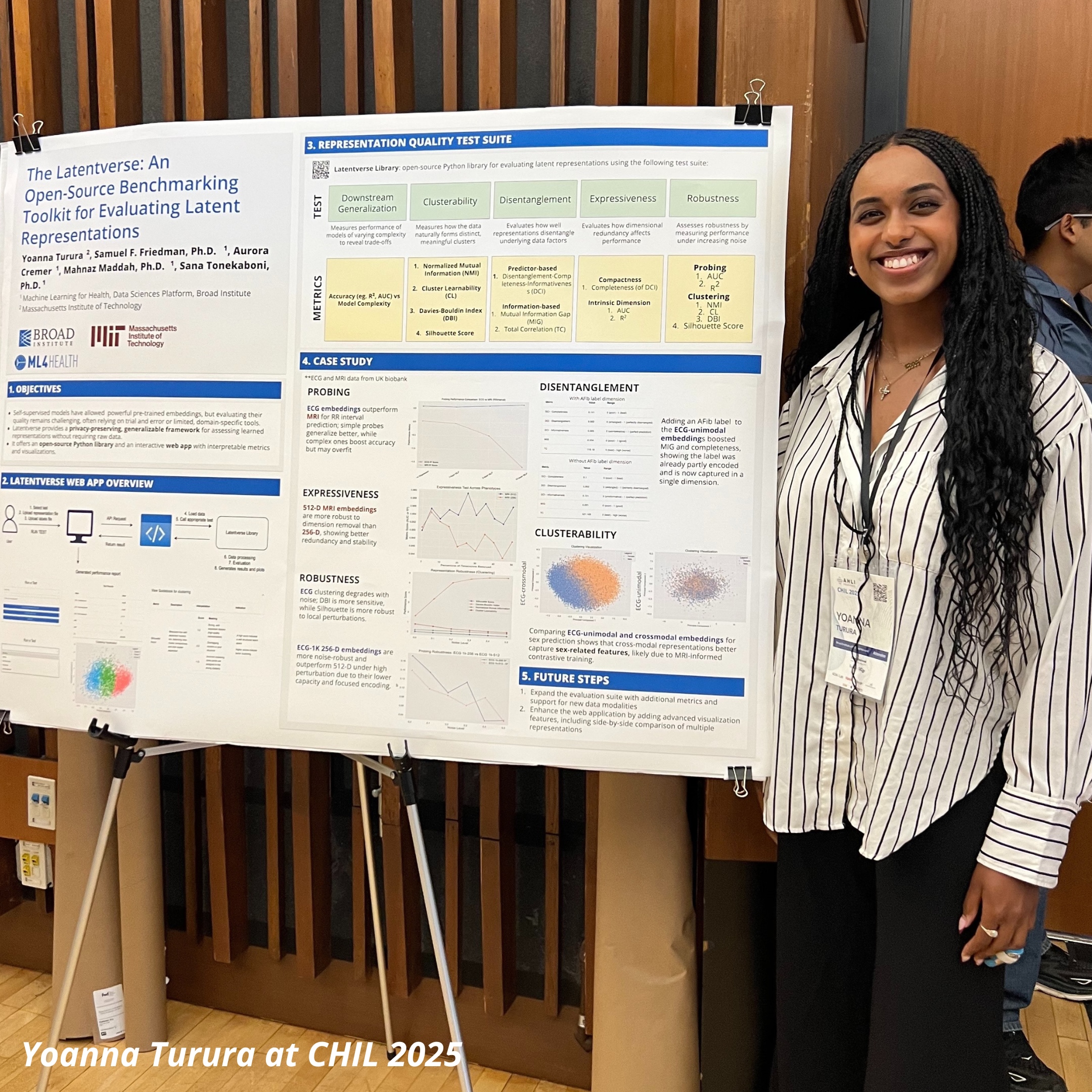

MEDIA INQUIRIES

Thank you for contacting the Eric and Wendy Schmidt Center. Your message has been received, and a staff member will get back to you shortly.
Oops! Something went wrong while submitting the form.
%20-%20header.png)
Before graduating with her bachelor’s degree in Artificial Intelligence and Decision Making from MIT, Yoanna Turura completed an ambitious step that few students experience so early in their careers: presenting original research at CHIL 2025, a leading conference at the intersection of machine learning and healthcare. Her project, called Latentverse, is a new open-source benchmarking toolkit for evaluating self-supervised learned representations in clinical data. It began during her time as a fellow at the Eric and Wendy Schmidt Center, shaped by the mentorship of Schmidt Center postdoctoral fellow Sana Tonekaboni.
Their paper, The Latentverse: An Open-Source Benchmarking Toolkit for Evaluating Latent Representations (Yoanna Turura, Sam Freesun Friedman, Aurora Cremer, Mahnaz Maddah, and Sana Tonekaboni), was accepted to CHIL 2025 – the 6th Annual Conference on Health, Inference, and Learning by the Association for Health Learning and Inference, held in June 2025 at UC Berkeley. For Yoanna, who had never submitted a paper before, the experience was a defining milestone and a chance to bring fresh ideas to a global community of researchers.
“Yoanna is a responsible and creative researcher,” said Sana. “She’s great at coming up with new ideas and then actually making them happen. While she's open to guidance, she often takes the lead, exploring new paths and developing her own unique methods, which really highlights her independent thinking. I really enjoyed working with her!”
We spoke with Yoanna before and after the conference to learn more about her work, how she prepared for her first major presentation, and how this experience will shape her next steps as a researcher.
---------
First, we caught up with Yoanna as she planned to attend CHIL.
Congratulations on your CHIL paper! How does it feel to have your work selected, especially as an undergraduate student?
I was really excited! This was my first time submitting a paper to a conference, and we had been working on the project since the beginning of the school year. It felt great to see our work recognized as useful to the field. As an early-career researcher, I’m thrilled I could contribute to something that could help others – and I can’t wait to share it with the community.
What are you most excited about at CHIL this year?
It’s my first time attending CHIL, and I’m eager to learn more about new, fascinating developments at the intersection of health and machine learning – an area I’m passionate about. I’m also looking forward to the roundtables, which I think will spark great dialogue and idea-sharing.
Tell us more about your work.
Self-supervised models can create powerful embeddings, but evaluating their quality remains a challenge as most tools are domain-specific, lack standardized metrics, or require raw data. We created Latentverse, an open-source library and web app that evaluates latent representations using a suite of interpretable tests, including probing, clustering, disentanglement, expressiveness, and robustness. It’s designed to help researchers compare and improve representation learning methods across domains.
How has Sana guided you?
Sana has been an incredible mentor during my first research experience. She was instrumental in my development and supported me from day one. Besides meeting regularly, she made herself available during any blockers that I had, helped with literature reviews, and provided detailed feedback as I created the framework. She made my experience more meaningful by bringing me to the broader Machine Learning for Health (ML4H) team, where I could brainstorm and present my ideas.
Sana encouraged me to submit my first paper on our joint work, and she was there through every step of the process – even late nights working together. I’ve learned so much from her skillful guidance, and I’m deeply inspired by her dedication to both the field and her mentees.
---------

Then, we chatted with Yoanna once she returned from the conference.
What were some of your highlights from CHIL?
I loved the panel discussions and Q&As. Coming from vastly different backgrounds, the speakers brought unique perspectives from across healthcare and focused on practical applications, like responsible AI integration or better evaluation for GenAI models. It was inspiring to hear candid reflections on what’s working, what’s not, and where the field is headed. I also learned about some groundbreaking, innovative tools that are being developed to improve the clinician and patient experience.
How did the poster presentation go?
It went really well! Lots of people stopped by to learn about Latentverse and they were curious about how it could be applied to their projects. Many had thoughtful questions about how to interpret the scores and visualizations, and some of that feedback has already sparked ideas for improving the web app. It was exciting to see people scan the QR code to the Latentverse library and want to use it in their own work. I was really glad to explain this tool to others.
Any recommendations for future undergraduates presenting at CHIL?
CHIL is all about bringing together people from diverse healthcare backgrounds (clinicians, entrepreneurs, computer scientists, and so on) to exchange ideas, share solutions, ideate how to advance the field, and collaborate. So don’t limit yourself to poster sessions – take advantage of the roundtables, coffee breaks, and lunch sessions to talk about your work and learn from others. CHIL encourages this kind of sharing and there is no better place for thoughtful conversation and community-building when everyone is united for a common purpose.
Yoanna will be starting as a software engineer at Amazon this summer.
